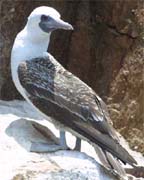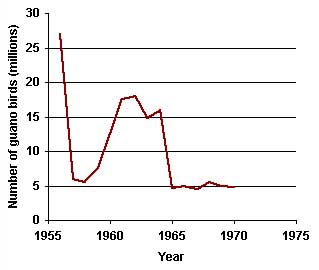|
These three species of birds are considered to be the primary producers of guano, which was considered an excellent fertilizer during the 19th and early 20th centuries. They are endemic to the islands off the coast of Peru, and feed almost exclusively on anchovies. Isolation on the islands protected the guano birds from many natural predators. Meanwhile, there was an abundance of their primary food source, anchovies, due to Peru's rich coastal waters. Consequently, their population grew to many millions, and they produced many thousands of tons of guano. It is estimated that around a million birds resided on one island, and were able to produce 11,000 tons of guano a year. |
|||||||||
|
This figure reveals the temporal progression of the dwindling guano birds population. Analyzing the graph more closely reveal the following insights:
- The numbers dropped significantly during 1957 (from 27 million to 5.5 million).
- There was a steady recovery during the early 1960s.
- Populations plummeted again in 1965, but there has not been signs of recovery.
- Were their significant events happening ecologically, politically, or socially during years of those dramatic drops that could explain that was going on?
- How could the anchovy industry impact the guano bird population?
This web site was created by Lynn Tran at the North Carolina State University, Department of Mathematics, Science, and Technology Education on 7/12/03. Faculty advisor Dr. David Eggleston, NCSU, Department of Marine, Earth, & Atmospheric Sciences. Last updated December 29, 2003 .



